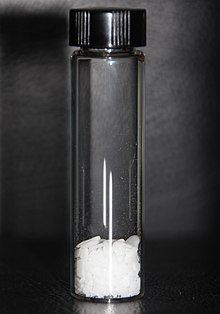Triphenylphosphine

| |

| |

| |

| |
| Names | |
|---|---|
| Preferred IUPAC name
Triphenylphosphane[1] | |
| Identifiers | |
3D model (
JSmol ) |
|
| ChEBI | |
| ChemSpider | |
ECHA InfoCard
|
100.009.124 |
| EC Number |
|
PubChem CID
|
|
RTECS number
|
|
| UNII | |
| UN number | 3077 |
CompTox Dashboard (EPA)
|
|
| |
| |
| Properties | |
| C18H15P | |
| Molar mass | 262.292 g·mol−1 |
| Appearance | White Solid |
| Density | 1.1 g cm−3, solid |
| Melting point | 80 °C (176 °F; 353 K) |
| Boiling point | 377 °C (711 °F; 650 K) |
| Insoluble | |
| Solubility | organic solvents |
| Acidity (pKa) | 7.64[2] (pKa of conjugate acid in acetonitrile)
2.73[3] (pKa of conjugate acid, aqueous scale) |
| -166.8·10−6 cm3/mol | |
Refractive index (nD)
|
1.59; εr , etc.
|
| Structure | |
| Pyramidal | |
| 1.4 - 1.44 D [4] | |
| Hazards | |
| GHS labelling: | |
 
| |
| Danger | |
| H302, H317, H350, H412 | |
| P201, P202, P261, P264, P270, P272, P273, P280, P281, P301+P312, P302+P352, P308+P313, P321, P330, P333+P313, P363, P405, P501 | |
| NFPA 704 (fire diamond) | |
| Flash point | 180 °C (356 °F; 453 K) |
| Safety data sheet (SDS) | Fisher Scientific |
| Related compounds | |
Related
tertiary phosphines |
Trimethylphosphine Phosphine |
Related compounds
|
Triphenylamine Triphenylarsine Triphenylstibine Triphenylphosphine oxide Triphenylphosphine sulfide Triphenylphosphine dichloride Triphenylphosphine selenide Pd(PPh3)4 |
Except where otherwise noted, data are given for materials in their standard state (at 25 °C [77 °F], 100 kPa).
| |
Triphenylphosphine (IUPAC name: triphenylphosphane) is a common
Preparation and structure
Triphenylphosphine can be prepared in the laboratory by treatment of phosphorus trichloride with phenylmagnesium bromide or phenyllithium. The industrial synthesis involves the reaction between phosphorus trichloride, chlorobenzene, and sodium:[5]
- PCl3 + 3 PhCl + 6 Na → PPh3 + 6 NaCl
Triphenylphosphine crystallizes in triclinic[6] and monoclinic modification.[7] In both cases, the molecule adopts a pyramidal structure with propeller-like arrangement of the three phenyl groups.
Principal reactions with chalcogens, halogens, and acids
Oxidation
Triphenylphosphine undergoes slow oxidation by air to give triphenylphosphine oxide, Ph3PO:
- 2 PPh3 + O2 → 2 OPPh3
This impurity can be removed by
Triphenylphosphine abstracts
Aryl
- PPh3 + PhN3 → PhNPPh3 + N2
The phosphanimine can be hydrolyzed to the amine. Typically the intermediate phosphanimine is not isolated.
- PPh3 + RN3 + H2O → OPPh3 + N2 + RNH2
Chlorination
Cl2 adds to PPh3 to give
- 2 Ph3PCl2 + NH2OH·HCl + Ph3P → {[Ph3P]2N}Cl + 4HCl + Ph3PO
Protonation
PPh3 is a weak base (aqueous pKaH = 2.73, determined electrochemically), although it is a considerably stronger base than NPh3 (estimated aqueous pKaH < –3).[11] It forms isolable triphenylphosphonium salts with strong acids such as HBr:[12]
- P(C6H5)3 + HBr → [HP(C6H5)3]+Br−
Organic reactions
PPh3 is widely used in organic synthesis. The properties that guide its usage are its nucleophilicity and its reducing character.[13] The nucleophilicity of PPh3 is indicated by its reactivity toward electrophilic alkenes, such as Michael-acceptors, and alkyl halides. It is also used in the synthesis of biaryl compounds, such as the Suzuki reaction.
Quaternization
PPh3 combines with
- PPh3 + CH3I → [CH3PPh3]+I−
These salts, which can often be isolated as crystalline solids, react with strong bases to form ylides, which are reagents in the Wittig reactions.
Aryl halides will quaternize PPh3 to give
- PPh3 + PhBr → [PPh4]Br
The reaction however requires elevated temperatures and metal catalysts.
Mitsunobu reaction
In the Mitsunobu reaction, a mixture of triphenylphosphine and diisopropyl azodicarboxylate ("DIAD", or its diethyl analogue, DEAD) converts an alcohol and a carboxylic acid to an ester. DIAD is reduced as it serves as the hydrogen acceptor, and the PPh3 is oxidized to OPPh3.
Appel reaction
In the Appel reaction, a mixture of PPh3 and CX4 (X = Cl, Br) is used to convert alcohols to alkyl halides. Triphenylphosphine oxide (OPPh3) is a byproduct.
- PPh3 + CBr4 + RCH2OH → OPPh3 + RCH2Br + HCBr3
This reaction commences with nucleophilic attack of PPh3 on CBr4, an extension of the quaternization reaction listed above.
Deoxygenation
The easy oxygenation of PPh3 is exploited in its use to deoxygenate organic peroxides, which generally occurs with retention of configuration:
- PPh3 + RO2H → OPPh3 + ROH (R = alkyl)
It is also used for the decomposition of organic ozonides to ketones and aldehydes, although dimethyl sulfide is more popular for the reaction as the side product, dimethyl sulfoxide is more readily separated from the reaction mixture than triphenylphosphine oxide. Aromatic N-oxides are reduced to the corresponding amine in high yield at room temperature with irradiation:[14]
Sulfonation

Reduction to diphenylphosphide
- (C6H5)2PM + H2O → (C6H5)2PH + MOH
Transition metal complexes
Triphenylphosphine binds well to most
Polymer-anchored PPh3 derivatives
Polymeric analogues of PPh3 are known whereby polystyrene is modified with PPh2 groups at the para position. Such polymers can be employed in many of the applications used for PPh3 with the advantage that the polymer, being insoluble, can be separated from products by simple filtration of reaction slurries. Such polymers are prepared via treatment of 4-lithiophenyl-substituted polystyrene with chlorodiphenylphosphine (PPh2Cl).
See also
- Tris(o-tolyl)phosphine
- Decyl(triphenyl)phosphonium
- Vaska's complex
- Wilkinson's catalyst
- Bis(triphenylphosphine)nickel(II) dichloride
- Bis(triphenylphosphine)palladium(II) dichloride
- Stryker's reagent
References
- ISBN 978-0-85404-182-4.
- ISSN 1434-193X.
- doi:10.1139/v82-106.
- .
- ISBN 0-444-89307-5.
- .
- .
- ISBN 978-0-08-022961-4.
- .
- )
- ISSN 0008-4042.
- ^ Hercouet, A.; LeCorre, M. (1988) Triphenylphosphonium bromide: A convenient and quantitative source of gaseous hydrogen bromide. Synthesis, 157–158
- ISBN 0-471-93623-5.
- ISBN 978-0-471-97926-5.
- )
- ISBN 978-0-470-13248-7.
- ^ ISBN 978-0-470-13247-0.
- ISBN 3-527-28165-7.
- .
- .


